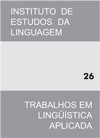Resumo
This work focuses on the concept of communicative competence, taking as it starting point the supposition that the strategic aspect is not taken into account in the classroom, although it could help cater to the unexpected si¬tuations in immersion to contexts faced by fo¬reign students in everyday in¬terac¬tions. Taking Ca¬nale (1983) as the theoretical point of departure, the stra¬tegic aspect of com¬muni¬ca¬tive competence was examined. However, this propo¬sal turns out to be limi¬ted once an analysis of the data is carried out. Vygotsky’s related theo¬rizations (1991 a,b) were considered to shed light on the cons¬truc¬tion of commu¬ni¬cative com¬petence in more informal and less directed inte¬rac¬tions, parti¬cu¬lary those observed in warm up activities. The peripheral stra¬te¬gic view of Canale was found to oppo¬se Vygotsky’s view considering cognitive development in a diale¬cti¬cal relationship with social elements, a re¬la¬tion denominated stra¬te¬gic activity by the latter. The data analysis reveals that the communicative appr¬oach to language teaching, as revealed in the classroom researched, does not actually consi¬der stu¬dent capa¬city to deal with unexpected si¬tuations, a fact proba¬bly related to the absence of a strategic processing trea¬tment in the classroom and to an idealized view of communicative competence in the literature on Applied Linguistics. The analysis also suggests t¬hat communicative competence cannot be tre¬ated in iso¬la¬tion from the social-ideological-cultural aspects of the interactions, nor from the con¬flicts that pervade them. These aspects treated are according to the orientation of Fairclough (1985).O periódico Trabalhos em Linguística Aplicada utiliza a licença do Creative Commons (CC), preservando assim, a integridade dos artigos em ambiente de acesso aberto, em que:
- A publicação se reserva o direito de efetuar, nos originais, alterações de ordem normativa, ortográfica e gramatical, com vistas a manter o padrão culto da língua, respeitando, porém, o estilo dos autores;
- Os originais não serão devolvidos aos autores;
- Os autores mantêm os direitos totais sobre seus trabalhos publicados na Trabalhos de Linguística Aplicada, ficando sua reimpressão total ou parcial, depósito ou republicação sujeita à indicação de primeira publicação na revista, por meio da licença CC-BY;
- Deve ser consignada a fonte de publicação original;
- As opiniões emitidas pelos autores dos artigos são de sua exclusiva responsabilidade.
Downloads
Não há dados estatísticos.

